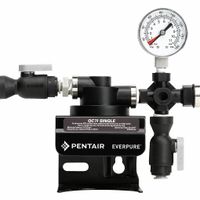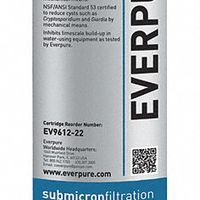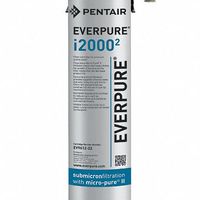Call +(254) 703 030 000 / 751 483 999 / 721 704 777
- Home
- Plumbing
- Water Filtration Purification Systems
- Appliance Water Filter Systems
Frequently Asked Questions
What contaminants do appliance water filter systems remove?
Appliance water filter systems are designed to remove a variety of contaminants to improve water quality and safety. These systems typically target the following:
1. **Chlorine and Chloramines**: Commonly used in municipal water treatment, these chemicals can affect taste and odor. Filters often use activated carbon to reduce these compounds.
2. **Sediments**: Particles like sand, silt, and rust can be removed through mechanical filtration, using materials like polypropylene or ceramic.
3. **Heavy Metals**: Filters can reduce metals such as lead, mercury, and cadmium, often using activated carbon or ion exchange resins.
4. **Volatile Organic Compounds (VOCs)**: These include industrial solvents and chemicals, which can be reduced by activated carbon filters.
5. **Pesticides and Herbicides**: Activated carbon is effective in reducing these agricultural chemicals.
6. **Microorganisms**: Some systems use UV light or advanced filtration to reduce bacteria, viruses, and protozoa.
7. **Pharmaceuticals**: Trace amounts of medications can be reduced by activated carbon filters.
8. **Nitrates and Nitrites**: Ion exchange and reverse osmosis systems can reduce these compounds, which are often found in agricultural runoff.
9. **Fluoride**: Some systems, particularly reverse osmosis, can reduce fluoride levels.
10. **Total Dissolved Solids (TDS)**: Reverse osmosis systems are effective in reducing TDS, which includes a variety of dissolved ions and minerals.
Different systems have varying capabilities, and the effectiveness depends on the filter technology used. It's important to choose a system that targets specific contaminants of concern based on water quality reports or testing.
How often should I replace the filter in my appliance water filter system?
The frequency of replacing the filter in your appliance water filter system depends on several factors, including the type of filter, the manufacturer's recommendations, the quality of your water supply, and your household's water usage. Generally, most water filter systems suggest replacing the filter every 3 to 6 months. However, this can vary:
1. **Type of Filter**:
- **Carbon Filters**: Typically need replacement every 3 to 6 months.
- **Reverse Osmosis Systems**: Pre-filters and post-filters usually require replacement every 6 to 12 months, while the RO membrane may last 2 to 3 years.
- **Sediment Filters**: Often need changing every 6 months, depending on water quality.
2. **Manufacturer's Recommendations**: Always follow the specific guidelines provided by the manufacturer of your appliance, as they design the system and understand its requirements best.
3. **Water Quality**: If your water supply has high levels of contaminants or sediment, you may need to replace filters more frequently. Hard water or water with high chlorine levels can also reduce filter lifespan.
4. **Water Usage**: Larger households or those with higher water consumption will likely need to replace filters more often than smaller households.
5. **Indicators**: Some modern systems have indicators or alarms that notify you when a filter change is necessary. Pay attention to these signals.
6. **Taste and Odor**: If you notice a change in the taste or odor of your water, it might be time to replace the filter, even if it's earlier than the recommended schedule.
Regular maintenance and timely filter replacement ensure optimal performance, water quality, and appliance longevity. Always keep track of replacement dates and monitor water quality to determine the best schedule for your specific needs.
Can appliance water filter systems improve the taste and odor of water?
Yes, appliance water filter systems can significantly improve the taste and odor of water. These systems are designed to remove impurities and contaminants that often contribute to unpleasant tastes and smells. Common substances that affect water quality include chlorine, sediment, organic compounds, and certain metals like lead and copper.
Chlorine, used in municipal water treatment, can leave a distinct taste and odor. Water filters, particularly those with activated carbon, are effective at reducing chlorine levels, resulting in better-tasting water. Activated carbon filters also absorb organic compounds that can cause musty or earthy odors.
Sediment filters remove particles such as sand, silt, and rust, which can affect the clarity and taste of water. By eliminating these particles, the water becomes clearer and more palatable.
Some advanced filtration systems, like reverse osmosis, can remove a broader range of contaminants, including dissolved solids and certain chemicals, further enhancing water quality. These systems can also reduce the presence of sulfur compounds, which are known for their rotten egg smell.
In addition to improving taste and odor, water filter systems can enhance the overall safety of drinking water by reducing harmful contaminants. This dual benefit makes them a popular choice for households looking to improve their water quality.
Overall, by targeting specific impurities, appliance water filter systems can transform tap water into a more enjoyable and safer beverage, making them a valuable addition to any home.
Are appliance water filter systems compatible with all brands and models?
Appliance water filter systems are not universally compatible with all brands and models. Compatibility depends on several factors, including the design, size, and connection type of the filter system and the appliance. Each appliance brand and model may have specific requirements for water filters, such as the shape, size, and type of filtration technology used.
Manufacturers often design water filters to fit specific models or a range of models within their brand. For instance, a water filter designed for a particular refrigerator model may not fit another model from the same brand or a different brand due to variations in the filter housing or connection points.
Additionally, the filtration technology, such as activated carbon, reverse osmosis, or sediment filters, may vary between brands and models, affecting compatibility. Some appliances may require filters with specific certifications or standards, such as NSF/ANSI certifications, to ensure water quality and safety.
To ensure compatibility, it is essential to check the appliance's user manual or manufacturer's website for recommended filter models. Some third-party manufacturers produce compatible filters for various brands, but it is crucial to verify their compatibility and quality standards.
In summary, while some water filter systems may be compatible with multiple brands and models, it is not a universal rule. Always verify compatibility with the specific appliance model to ensure proper fit and function.
How do I install an appliance water filter system?
1. **Choose the Right Filter**: Select a filter system compatible with your appliance and water needs.
2. **Gather Tools and Materials**: You may need a wrench, screwdriver, Teflon tape, and the filter kit.
3. **Turn Off Water Supply**: Shut off the water supply to the appliance to prevent leaks.
4. **Locate Installation Point**: Identify where the filter will be installed, usually on the water line leading to the appliance.
5. **Cut the Water Line**: Use a pipe cutter to cut the water line where the filter will be installed. Ensure the cut is clean and straight.
6. **Install the Filter Housing**: Attach the filter housing to the water line. Use Teflon tape on threaded connections to prevent leaks.
7. **Connect the Water Lines**: Attach the inlet and outlet water lines to the filter housing. Ensure connections are secure.
8. **Mount the Filter**: Secure the filter housing to a stable surface using brackets or screws provided in the kit.
9. **Insert the Filter Cartridge**: Open the filter housing and insert the filter cartridge. Ensure it is seated correctly.
10. **Check for Leaks**: Turn the water supply back on and check for leaks. Tighten connections if necessary.
11. **Flush the System**: Run water through the filter for a few minutes to remove any air and impurities.
12. **Test the Water**: Check the water quality to ensure the filter is functioning properly.
13. **Regular Maintenance**: Replace the filter cartridge as recommended by the manufacturer to maintain water quality.
What is the difference between a filter head and a filter housing?
A filter head and a filter housing are components of a filtration system, but they serve different functions.
A filter head is the part of the filtration system that connects the filter to the system's piping. It acts as the interface between the filter element and the fluid system. The filter head typically includes inlet and outlet ports for fluid flow, and it may also contain features such as pressure gauges, bypass valves, or indicators to monitor the filter's condition. The filter head is designed to securely hold the filter element in place and ensure a proper seal to prevent leaks.
On the other hand, a filter housing is the enclosure that contains the filter element. It provides a protective casing around the filter, ensuring that the fluid being filtered is directed through the filter media. The housing is designed to withstand the pressure and temperature of the system and is often made from materials like metal or plastic, depending on the application. The filter housing can be opened or disassembled to replace the filter element when it becomes clogged or reaches the end of its service life.
In summary, the filter head is primarily responsible for connecting and securing the filter to the system, while the filter housing encloses and protects the filter element, directing fluid through it for filtration. Both components are essential for the proper functioning of a filtration system, ensuring that contaminants are effectively removed from the fluid.
Do appliance water filter systems require professional maintenance?
Appliance water filter systems generally do not require professional maintenance, but it depends on the complexity of the system and the user's comfort level with maintenance tasks. Most household water filter systems, such as those found in refrigerators, under-sink units, or countertop models, are designed for easy maintenance by the user. These systems typically involve simple tasks like replacing filter cartridges, which can often be done without professional help. Manufacturers usually provide detailed instructions and guidelines for these replacements, making it straightforward for users to perform the task themselves.
However, some more complex systems, such as whole-house water filtration systems, might benefit from professional maintenance. These systems can involve intricate plumbing connections and multiple stages of filtration, which may require specialized knowledge to service properly. Professional maintenance can ensure that the system is functioning optimally, identify potential issues before they become significant problems, and extend the lifespan of the system.
In addition, professional maintenance might be necessary if the system experiences issues beyond basic filter replacement, such as leaks, unusual noises, or a noticeable decline in water quality. In such cases, a professional can diagnose and fix the problem more efficiently and safely than a typical homeowner.
Ultimately, whether professional maintenance is required depends on the type of water filter system, the user's technical skills, and the specific maintenance needs of the system. Regularly following the manufacturer's maintenance schedule and guidelines is crucial to ensure the system operates effectively and provides clean, safe water.


